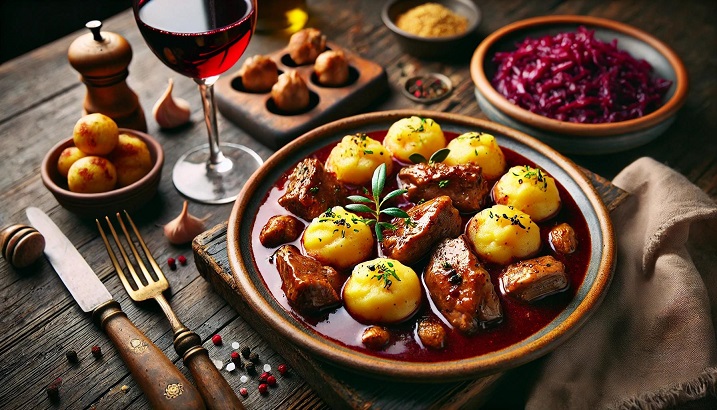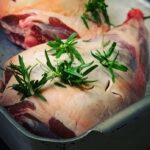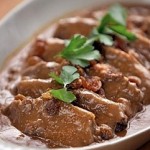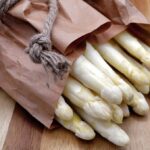
Hase in Rotweinsauce is a traditional German dish made with rabbit braised in a savory red wine sauce. It’s a popular choice for Easter Sunday dinner in many parts of Germany, especially in Bavaria, Baden-Württemberg, and rural areas, where wild or farm-raised rabbit is a spring delicacy.
The meat is first marinated in red wine and aromatic herbs, then seared and slow-cooked with vegetables until tender. The result is a rich, comforting stew, often served with potato dumplings, red cabbage, or spätzle.
In this guide, you’ll learn about the cultural background of Hase in Rotweinsauce and how to make this dish from scratch.
History & Cultural Significance
The Origins of Hase in Rotweinsauce
Rabbit has been a staple in German kitchens for centuries, especially in rural and southern regions, where it was often raised or hunted for Sunday roasts and special occasions. At Easter, serving rabbit became symbolic—celebrating renewal, spring, and the fertility of nature.
In traditional German cuisine, rabbit is often prepared with wine-based marinades, a method that not only tenderizes the meat but infuses it with deep flavor. Red wine sauces are especially popular in Bavaria, Swabia, and the Palatinate, where robust regional wines enhance the dish.
This dish is commonly served on festive occasions and often paired with earthy, rustic sides like spätzle, dumplings, or seasonal vegetables.
Looking for other Easter mains? Explore Oster Lammbraten and Osterbraten.
Ingredients & Preparation
Ingredients
For the Marinade:
- 500ml (2 cups) dry red wine
- 1 onion, sliced
- 2 garlic cloves, crushed
- 1 carrot, sliced
- 1 celery stalk, chopped
- 2 bay leaves
- 4 juniper berries (optional)
- 1 tsp black peppercorns
For the Stew:
- 1 whole rabbit (about 1.2–1.5 kg), cut into pieces
- 2 tbsp oil or clarified butter
- 1 tbsp tomato paste
- 250ml (1 cup) beef or game stock
- Salt and pepper to taste
- 1 tbsp flour (for thickening)
Optional:
- A splash of cream or sour cream to finish the sauce
How to Make Hase in Rotweinsauce
Step 1: Marinate the Rabbit
- Place rabbit pieces in a bowl with all marinade ingredients.
- Cover and refrigerate for 12–24 hours, turning occasionally.
Step 2: Brown the Meat
- Remove the rabbit, pat dry, and reserve the marinade.
- In a Dutch oven or large pot, heat oil and brown the rabbit on all sides. Remove and set aside.
Step 3: Build the Sauce
- Add the vegetables from the marinade and sauté briefly.
- Stir in tomato paste and cook for 1–2 minutes.
- Sprinkle with flour and stir well.
- Pour in the wine marinade and stock. Bring to a simmer.
Step 4: Braise and Finish
- Return rabbit to the pot, cover, and simmer for 60–75 minutes, until tender.
- Adjust seasoning. Optionally, stir in cream for a richer sauce.
Serving Suggestions & Variations
How to Serve
Hase in Rotweinsauce is traditionally served with:
- Kartoffelknödel (potato dumplings)
- Spätzle or egg noodles
- Braised red cabbage or spring vegetables
- A glass of dry red wine
Variations
In Bavaria, the sauce is often finished with sour cream or cream cheese. In Alsace and the Rhineland, rabbit is sometimes cooked with mushrooms and bacon for extra depth.
For a similar dish, try Osterbraten or Lachs mit Senfsauce.
Hase in Rotweinsauce is a beautifully rustic and flavorful Easter dish that showcases traditional German cooking at its best. With its tender meat and deeply aromatic red wine sauce, it’s perfect for holiday dinners or weekend gatherings.
Pair it with classic sides like spätzle and red cabbage for a memorable meal rooted in German tradition.
Looking for more German Easter dishes? Try Osterlammbraten, Kartoffelsalat, or Frühlingsgemüse.







